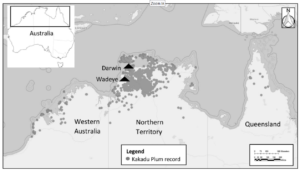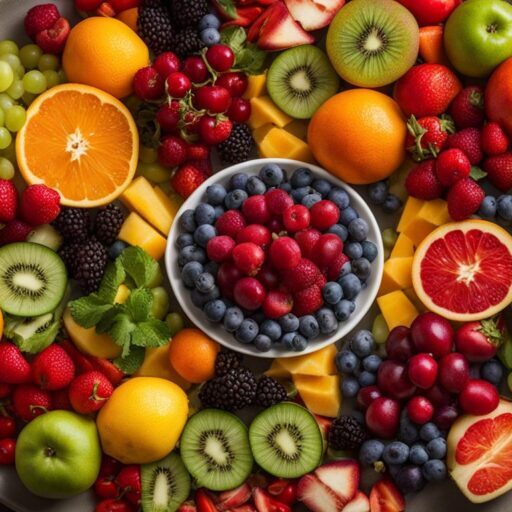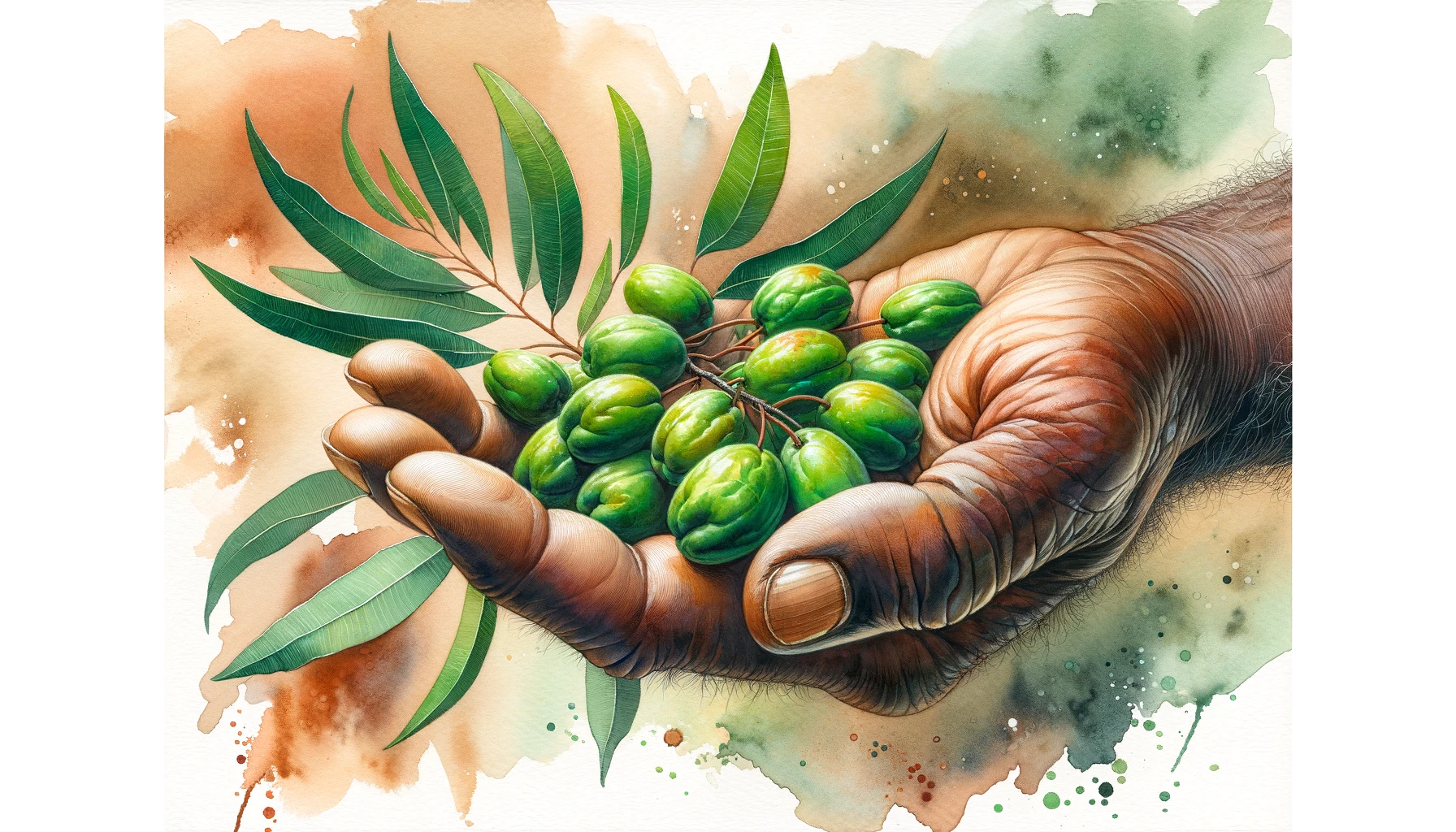The Kakadu Plum is a fruit from northern Australia, also known as Terminalia ferdinandiana. It stands out as a superfood, rich in nutrients and antioxidants. Indigenous Australians have prized it for centuries, both for healing and nutrition.
Vitamin C, or ascorbic acid, is key for our health. It’s a strong antioxidant that protects our cells, boosts collagen, strengthens the immune system, and helps absorb iron. Getting enough vitamin C is crucial for our body to function well. Its also recently been seen as playing an important role in Cell Signaling and Epigenetics. Ellagic Acid and Gallic Acid are present in high quantities in Kakadu Plum, and are polyphenols with powerful Epigenetic health effects.
Epigenetics is about how genes can change their activity without any change to the DNA itself. It looks at DNA and protein changes, like DNA methylation and histone modification. These changes can affect how genes work and are influenced by what we eat and our lifestyle. Epigenetics is important for understanding health and diseases.
The Vitamin C Powerhouse: Kakadu Plum
Kakadu plum, is indigenous to Northern Australia, and it’s celebrated as a superfood because it’s packed with nutrients and antioxidants. Indigenous Australians have used it for centuries, both as medicine and food.

Map of Kakadu Plum habitat in Australia’s Top End. (From Gorman 2020)
Overview of Kakadu plum as a rich natural source of Vitamin C
Kakadu plum is known for its amazing vitamin C levels. It has way more vitamin C than other fruits. This makes it a top source of this vital nutrient. The high vitamin C helps give it many health benefits.
Here’s a list of ten fruits known for their high vitamin C content, ranked based on their approximate vitamin C levels per 100 grams of fresh fruit:
- Kakadu plum (Terminalia ferdinandiana): 2300 to 3150 milligrams of vitamin C
- Acerola cherry (Malpighia emarginata): 1500 to 4500 milligrams of vitamin C
- Camu camu (Myrciaria dubia): 2000 to 2800 milligrams of vitamin C
- Rose hips (Rosa spp.): 426 to 4260 milligrams of vitamin C
- Guava (Psidium guajava): 228 to 228 milligrams of vitamin C
- Kiwi (Actinidia deliciosa): 92 to 93 milligrams of vitamin C
- Strawberries (Fragaria × ananassa): 59 to 60 milligrams of vitamin C
- Oranges (Citrus × sinensis): 53 to 53 milligrams of vitamin C
- Papaya (Carica papaya): 60 to 62 milligrams of vitamin C
- Pineapple (Ananas comosus): 47 to 48 milligrams of vitamin C
Nutritional profile of Kakadu plum compared to other fruits
Kakadu plum has an outstanding nutritional profile. It’s full of vitamin C, essential minerals like potassium, magnesium, and calcium, plus antioxidants and phytochemicals such as Gallic Acid and Ellagic Acid .
Kakadu plum stands out for its exceptionally high vitamin C content compared to other fruits. It also provides significant amounts of other nutrients such as vitamin E, potassium, and dietary fiber. Incorporating Kakadu plum into the diet can offer a range of health benefits due to its rich nutritional profile.
Nutritional comparison of Kakadu plum, oranges, strawberries, blueberries, and apples in a table format:
| Nutrient (per 100g, fresh) | Kakadu Plum | Oranges | Strawberries | Blueberries | Apples |
|---|---|---|---|---|---|
| Vitamin C | 2300-3150mg | 53mg | 59mg | 9.7mg | 4.6mg |
| Vitamin E | 1.4mg | 0.18mg | 0.29mg | 0.57mg | 0.18mg |
| Potassium | 259mg | 166mg | 153mg | 77mg | 107mg |
| Dietary fiber | 9.9g | 2.4g | 2.0g | 2.4g | 2.4g |
| Protein | 0.9g | 1.0g | 0.8g | 0.7g | 0.3g |
| Energy (kJ) | 102kJ | 197kJ | 136kJ | 240kJ | 218kJ |
This table provides a clear visual comparison of the nutritional content of Kakadu plum and other well-known fruits, allowing for easy identification of their respective nutrient profiles.
Traditional uses of Kakadu plum by Indigenous Australians
Indigenous Australians have used Kakadu plum for medicine and in their culture for a long time. They used it to help with infections, skin problems, and stomach issues. It’s also part of traditional ceremonies and food.
Kakadu Plum – Vitamin C and Its Role in Epigenetics
Epigenetic mechanisms like DNA methylation and histone modification regulate gene expression. DNA methylation adds a methyl group to DNA, influencing gene activity. Histone modification involves changes to histones, which package DNA, affecting gene access and expression.
vitamin C is considered one of the most important antioxidants in plants and animals. In addition to direct ROS neutralization, ascorbic acid is crucial for regeneration of other antioxidant food substances, e.g., vitamin E. This makes vitamin C an important redox node, particularly in conjunction with glutathione [2]. In line with its antioxidant capabilities, vitamin C has also been demonstrated to influence important intracellular signal transduction pathways. Thereby, vitamin C appears to be an important cofactor for enzymes that regulate the activity of transcription factors such as hypoxia-inducible factor-1α (HIF-1α) or nuclear factor kappa-light-chain-enhancer of activated B cells (NF-κB) that are activated in the context of physiological or pathological environmental conditions such as oxygen deprivation or inflammation [3]. Recent evidence also indicates that vitamin C can influence the epigenetic program of cells by participating in enzyme reactions that modify histone and DNA methylation patterns in response to external influences such as stress, disease, or diet. (Kietzman 2023)
Studies show vitamin C affects epigenetic regulation and gene expression. Vitamin C supplementation alters DNA methylation and histone modifications. These effects might contribute to its health benefits and disease protection. Yet, more research is necessary to understand vitamin C’s role fully in epigenetics.
Potential Health Benefits of Kakadu Plum – Polyphenols
As well as high concentrations of Vitamin C, Kakadu Plum also contains high concentrations of Polyphenols such as Ellagic Acid and Gallic Acid.
Kakadu plum fruits were found to contain very high levels of polyphenolic compounds, mainly ellagic acid (EA) and gallic acid. Eshetu et al. reported in 2020 that Kakadu plums can still maintain a high level of ellagic acid content (46.6 mg/g) in freeze-dried form [16]. The content of gallic acid is 5.10 ± 0.03 mg/g DW, which is much higher than that of lemons, oranges, and blueberries [17]. A study by Williams et al. (2014) showed that the ellagic acid content of the Kakadu plum (880.9 mg/100 g) was significantly higher than that of boysenberry (166.4 mg/100 g) on a dry weight basis, even though boysenberry is known to be an ellagic-acid-rich natural fruit [12]. In addition, ellagic acid has also been reported to have anti-inflammatory, anti-cancer, and anti-aging properties, as well as improving symptoms such as Alzheimer’s disease, diabetes, and cardiovascular diseases [18,19]. These compounds, like ascorbic acid, also have very high antioxidant properties and can reduce the risk of many chronic diseases such as cardiovascular disease, stroke, and rheumatoid arthritis [12,20]. (Zhou 2023)
Note that the ellagic acid concentrations can vary depending on factors such as cultivar, growing conditions, and maturity of the fruit or nut at the time of analysis.
Ellagic Acid
Ellagic Acid is found in fruits and nuts, either in the combined form with hexahydroxydiphenic acid or in the bound form (ellagitannins). EA exhibits many biological properties such as antioxidant, anti-diabetic, anticancer and apoptosis-inducing activities. These biological and pharmacological properties are relevant to the treatment of several human diseases. (Shakiri 2018)
Ellagic Acid has many positive health effects, but the extent of these health effects is dependant on how the intestinal flora in the human gut processes the Ellagic Acid into Urolithins.
Urolithins (Uros) have gained recognition as one of the main drivers for the health effects related to the intake of ellagitannins (ETs) and ellagic acid (EA)-rich foods such as nuts, pomegranates, many tropical fruits, and berries such as blackberries and raspberries. The human gut microbiota converts these polyphenols into Uros. (Igglesis-Aguire 2023)
Gallic Acid also has potent epigenetic effects and is a potent anti-cancer compound:
Human diseases such as cancer can be caused by aberrant epigenetic regulation. Polyphenols play a major role in mammalian epigenome regulation through mechanisms and proteins that remodel chromatin. In fruits, seeds, and vegetables, as well as food supplements, polyphenols are found. Compounds such as these ones are powerful anticancer agents and antioxidants. Gallic acid, kaempferol, curcumin, quercetin, and resveratrol, among others, have potent anti-tumor effects by helping reverse epigenetic changes associated with oncogene activation and tumor suppressor gene inactivation. (Rajendran 2022)
Discussion of the potential health benefits associated with Ellagic Acid
Anti-inflmmatory
Ellagic acid exhibited a potent anti-inflammatory effect against carrageenan-induced inflammation (El-Shitany et al., 2014). The mechanisms by which ellagic acid protected against inflammation could be linked to the reduction of inflammatory molecules such as, nitric oxide (NO), malondialdehyde (MDA), interleukin-1 beta (IL-1β), tumor necrosis factor alpha (TNF-α), cyclooxygenase 2 (COX-2) and nuclear factor-κB (NF-κB) expression, and the induction of glutathione (GSH) and IL-10 production (El-Shitany et al., 2014). (Sanchez-Gonzalez 2015)
UV Protection
Ellagic acid may be useful for the treatment of ultra-violet induced skin damage. In an in vitro
study, Hseu et al (2012) showed that an ellagic acid pre-treatment markedly increased HaCaT
human keratocyte cell viability and suppressed UVA-induced ROS generation and malondialdehyde (MDA) formation (Hseu et al., 2012). Moreover, ellagic acid pre-treatment prevented UVA-induced DNA damage and significantly inhibited the UVA-induced apoptosis of HaCaT cells. (Sanchez-Gonzalez 2015)
Colon Cancer
Exposure of Caco-2 (colon adenocarcinoma) cells to ellagic acid and urolithins arrested cell growth at the S- and G2/M-phases, which could have been related to a decrease in the expression levels of
MAPK signaling genes, tumor suppressors and genes involved in cell cycle (González-Sarrías et
al., 2009). Another signaling pathway known to play a pivotal role in human colon carcinogenesis is the Wnt pathway. An inappropriate activation of this signaling cascade is observed in 90% of colorectal cancers. Wnt transcriptional activation was explored in a human 293T colon cancer cell line, cells were incubated with ellagitannin extracts from several food sources, including strawberries and pomegranate, and specific polyphenols, ellagic acid (63μM) and urolithin A (39μM). All extracts, ellagic acid, and urolithin A inhibited Wnt-dependent signaling, a promising effect against colon carcinogenesis (Sharma et al., 2010). (Sanchez-Gonzalez 2015)
Liver Protection
EA, a naturally occurring polyphenolic compound, shows several potential pharmacological properties mainly associated with their ability to modulate the cell redox changes. EA prevents liver toxicity induced by alcohol, CCl4, cisplatin, ConA, CsA, d-Gal/LPS, isoniazid and rifampicin, Hg and paracetamol by mechanisms related with free radicals scavenging, chelation of divalent ions, modulation of CYP450 enzymes activity, upregulation of Nrf2 and downregulation of NF-κB and proinflammatory…. (Garcia-Nino 2015)
Diabetes and diabetic complications
Globally, more than 400 natural products have been investigated in diabetes and its complications. Tannins are the polyphenolic compounds present in many medicinal plants and various dietary sources like fruits, nuts, grains, spices and beverages. Various reports have shown that compounds like gallic acid, ellagic acid, catechin, epicatechin and procynidins from medicinal plants play major role in controlling progression of diabetes and its related complications by acting on molecular pathways and key targets involved in progression. (Laddha 2022)
Conclusion
Kakadu Plum, or Terminalia ferdinandiana, is a fruit from northern Australia. It’s known for its strong nutrition and antioxidants. Indigenous Australians have used it for its health benefits and as food for centuries.
We have highlighted how the Kakadu plum is a superfood because of its vitamin C and polyphenols, particularly Ellagic Acid and Gallic Acid. Future research into its medicinal and nutritional effects will provide us with a better picture of how important the Kakadu Plum may be, for not just Indigenous Australians but for all.
Please note that this is an informational article only. Any medical treatment should only be taken in consultation with an appropriate medical practitioner.


